CONCEPT13.4 Biotechnology Has Wide Applications
In the opening story of this chapter we defined biotechnology as the use of cells or whole living organisms to make or modify materials or processes that are useful to people, such as foods, medicines, and chemicals. Bacteria and yeast cells can be transformed with almost any gene, and they can be induced to express that gene at high levels and to export the protein product out of their cells. This technology has turned these microbes into versatile factories for many important products. Today there is interest in producing nutritional supplements and pharmaceuticals in whole transgenic animals and plants and harvesting the products in large quantities—for example, from cow’s milk or rice grains. Another goal is to produce animals and plants with improved characteristics, such as increased nutritional value or better tolerance of harsh environments. Key to this boom in biotechnology has been the development of specialized vectors that not only carry genes into animal and plant cells, but also make those cells express the genes at high levels.
Expression vectors can turn cells into protein factories
Many proteins that are potentially useful to humans come from eukaryotes. But if a eukaryotic gene is inserted into a typical plasmid and used to transform E. coli, none of the gene product will be made. Other key prokaryotic DNA sequences must be included with the gene. A bacterial promoter, a signal for transcription termination, and a special sequence that is necessary for ribosome binding on the mRNA must all be included in the transformation vector if the gene is to be expressed in the bacterial cell. In addition, the eukaryotic coding region must be made using cDNA so that it has no introns.
To solve this kind of problem, scientists make expression vectors that have all the characteristics of typical vectors, as well as the extra sequences needed for the foreign gene (also called a transgene) to be expressed in the host cell. For bacterial hosts, these additional sequences include the elements named above (FIGURE 13.11). For eukaryotes, they include the poly A addition sequence and a promoter that contains all the elements needed for expression in a eukaryotic cell. An expression vector can include various types of promoters and other features:
- An inducible promoter, which responds to a specific signal, can be included. For example, a promoter that responds to hormonal stimulation (e.g., a promoter containing the auxin response element described earlier) can be used so that the transgene will be expressed at high levels only when the hormone is added.
- A tissue-specific promoter, which is expressed only in a certain tissue at a certain time, can be used if localized expression is desired. For example, many seed proteins are expressed only in the plant embryo. Coupling a transgene to a seed-specific promoter will allow the gene to be expressed only in seeds and not, for example, in leaves.
- Signal sequences can be added so that the gene product is directed to an appropriate destination. For example, when a protein is made by yeast or bacterial cells in a liquid medium, it is economical to include a signal directing the protein to be secreted into the extracellular medium for easier recovery.
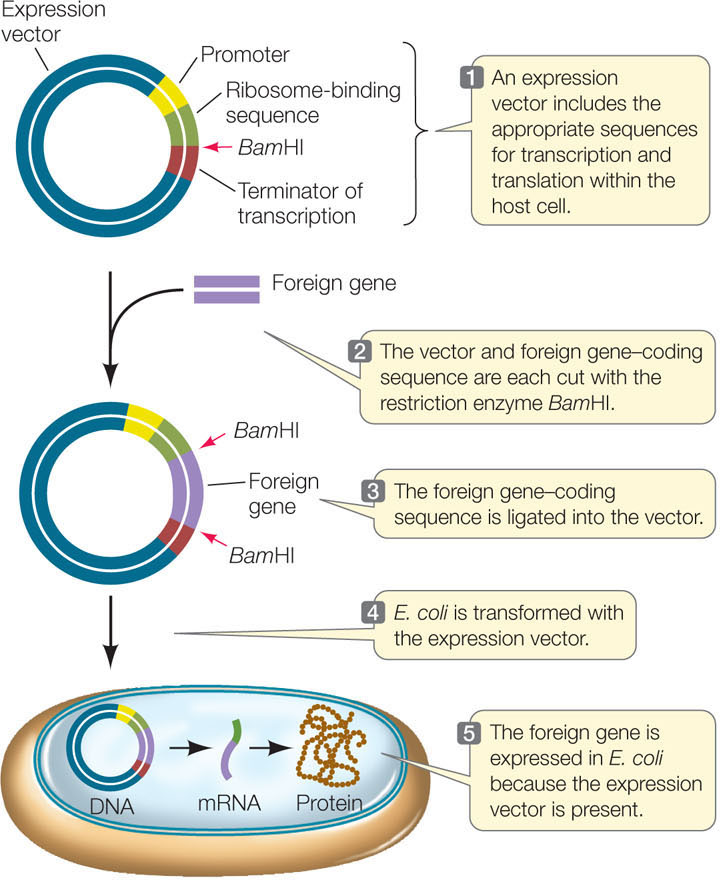
266
LINK
You can review the mechanisms of transcription and mRNA processing in Concept 10.2, transcriptional regulation in Concepts 11.2 and 11.3, and signal sequences in Concept 10.5
Medically useful proteins can be made by biotechnology
Some medically useful products are being made by biotechnology (TABLE 13.1), and more are in various stages of development. Human insulin was the first medicine to be made using recombinant DNA, and provides a good illustration of a medical application of biotechnology. Insulin is essential for glucose uptake into cells. People with type I diabetes mellitus cannot make this hormone and must receive insulin injections. Before the advent of biotechnology, the insulin used for this purpose came from cattle and pigs.

Insulin is a protein of 51 amino acids and is made up of two polypeptide chains. The amino acid sequence of insulin from cattle differs from the human sequence by three amino acids, and the pig sequence differs from that of humans by just one amino acid. These differences are enough to cause an immune reaction in some patients who are diabetic, and these patients need to be treated with the human protein. Since the hormone is made in tiny amounts, harvesting enough from deceased persons is not practical. Recombinant DNA biotechnology solved this problem.
FIGURE 13.12 illustrates the strategy that was originally used to make human insulin in E. coli (today it is often made in yeast). The two insulin polypeptides were synthesized separately using an expression vector containing the gene for β-galactosidase (lacZ). Each insulin gene was inserted into the vector in such a way that it was induced, transcribed, and translated along with the β-galactosidase gene. After extraction and purification of the β-galactosidase–insulin fusion proteins, the insulin polypeptides were cleaved off by chemical treatment. The two insulin peptides were then combined to make a complete, functional human insulin molecule.
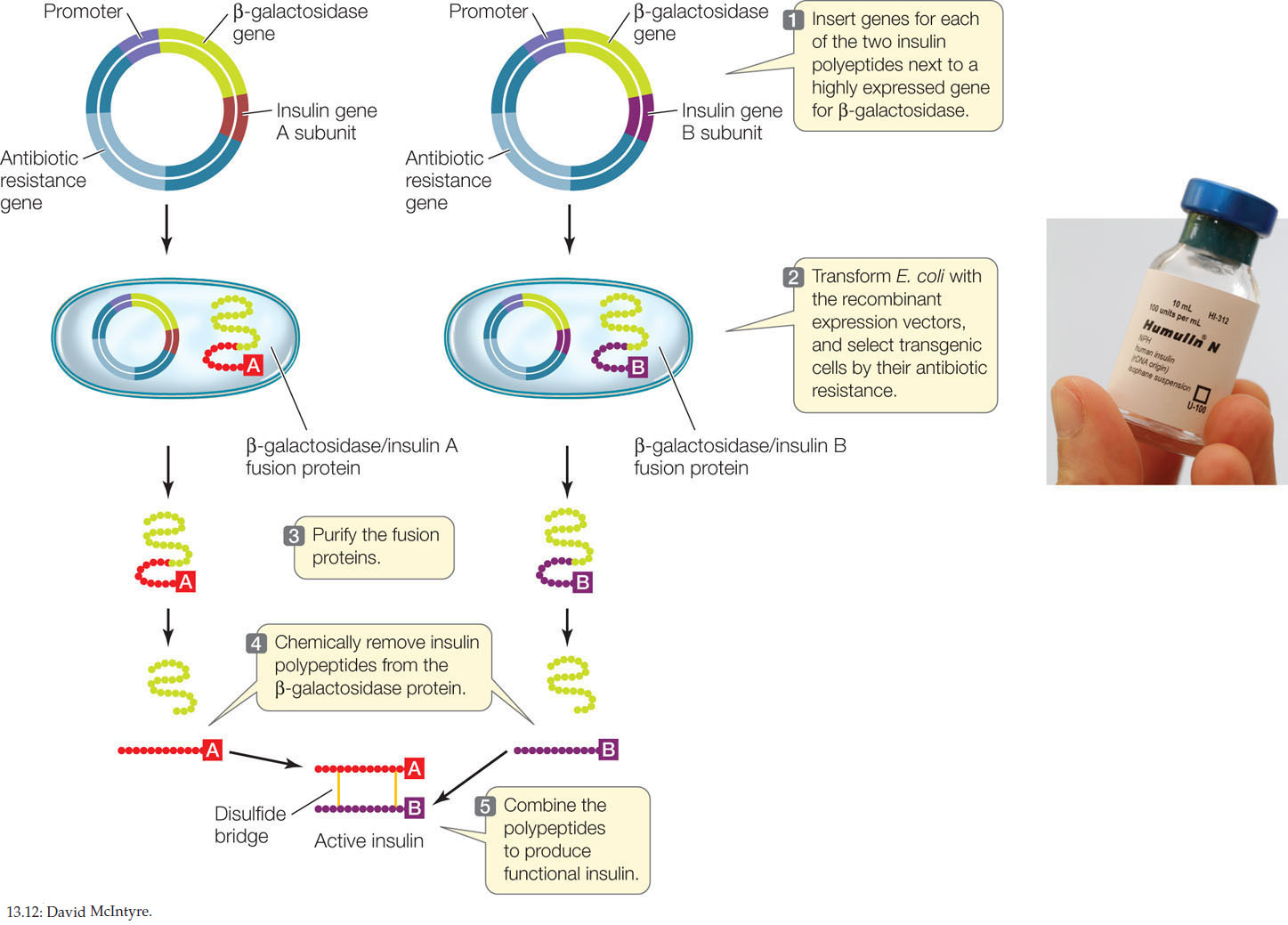
Before giving it to human patients, scientists had to be confident that the product made by biotechnology was functional human insulin. Several lines of evidence supported such confidence:
- The synthetic protein is the same size as human insulin.
- It has the same amino acid sequence.
- It has the same shape, as measured by physical techniques.
- It binds to the insulin receptor on cells and stimulates glucose uptake.
LINK
The crucial role of insulin in regulating glucose metabolism is detailed in Concept 30.5
Another way of making medically useful products in large amounts is pharming: the production of pharmaceuticals in farm animals or plants. For example, a gene encoding a useful protein might be placed next to the promoter of the gene that encodes lactoglobulin, an abundant milk protein. Transgenic animals carrying this recombinant DNA will secrete large amounts of the foreign protein into their milk. These natural “bioreactors” can produce abundant supplies of the protein, which can be separated easily from the other components of the milk (FIGURE 13.13).
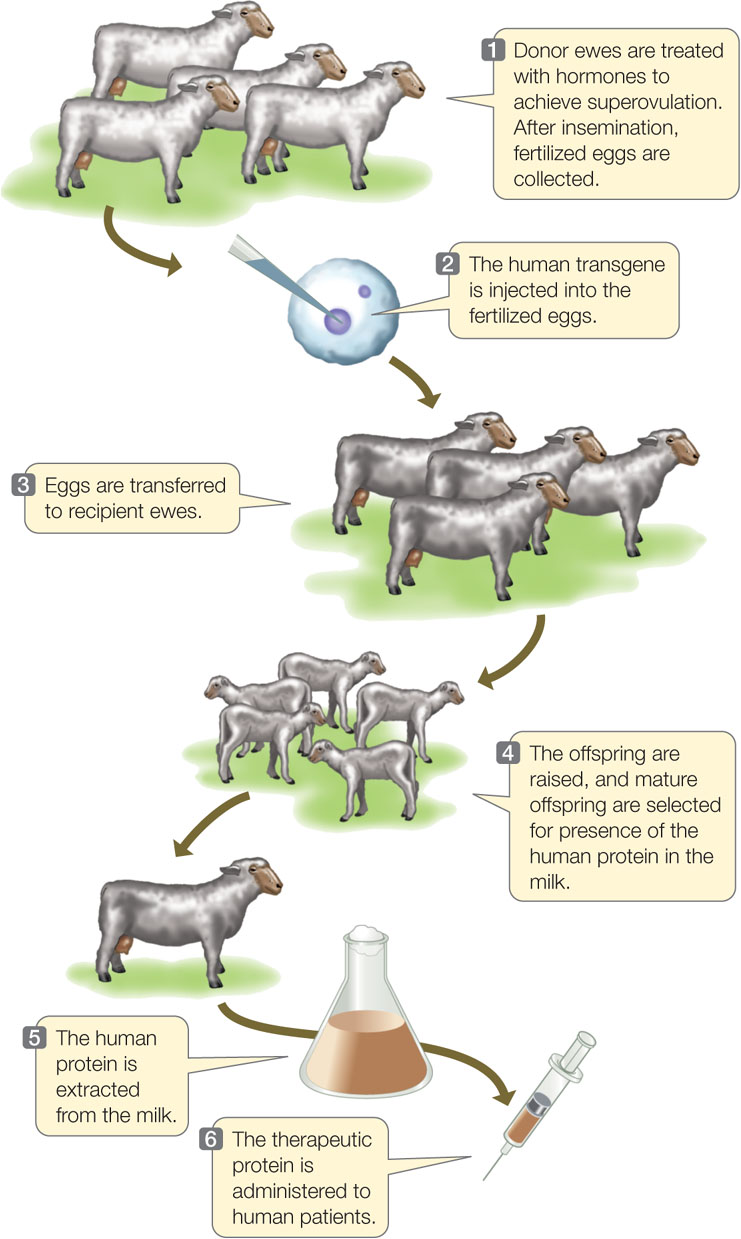
267
Human growth hormone (hGH) is a protein made in the pituitary gland and has many effects, especially in growing children. People with hGH deficiencies have short stature as well as other abnormalities, a condition known as pituitary dwarfism. In the past they were treated with hGH isolated from the pituitary glands of dead people, but the supply was too limited to meet demand. Recombinant DNA technology was used to coax bacteria into making this protein, but the cost of treatment was high ($30,000 a year). In 2004, a team led by Daniel Salamone at the University of Buenos Aires produced a transgenic cow that secretes hGH in her milk. The yield is prodigious: a mere 15 such cows could meet the worldwide demand of children suffering from this type of dwarfism.
Plants and plant cells can be genetically transformed and induced to make proteins. Recently the first drug produced by plant biotechnology was approved by the U.S. government. The drug is an enzyme used to treat Gaucher’s disease, an inherited disorder that affects the breakdown of certain lipids in lysosomes. More than 10,000 patients worldwide may soon be using this enzyme, made by transgenic carrot cells.
DNA manipulation is changing agriculture
The cultivation of plants and the husbanding of animals provide the world’s oldest examples of biotechnology, dating back more than 10,000 years. Over the centuries, people have adapted crops and farm animals to their needs. Through selective breeding of these organisms, desirable characteristics such as large seeds, high fat content in milk, or resistance to disease have been selected for and improved.
The traditional way to improve crop plants and farm animals was to identify individuals with desirable phenotypes that existed as a result of natural variation. Through deliberate crosses, the genes responsible for the desirable traits could be introduced into widely used varieties or breeds. Despite some spectacular successes, such as the breeding of high-yielding varieties of wheat, rice, and hybrid corn, such deliberate crossing has been a hit-or-miss affair. Many desirable traits are controlled by multiple genes, and it is hard to predict the results of a cross or to maintain a prized combination in a true-breeding variety. In sexual reproduction, combinations of desirable genes are quickly separated by meiosis. Furthermore, traditional breeding takes a long time: many plants and animals take years to reach maturity and then can reproduce only once or twice a year.
268
Recombinant DNA technology has several advantages over traditional methods of breeding (FIGURE 13.14):
- The ability to identify specific genes. The development of genetic markers allows breeders to select for specific desirable genes, making the breeding process more precise and rapid.
- The ability to introduce any gene from any organism into a plant or animal species. This ability, combined with mutagenesis techniques, vastly expands the range of possible new traits.
- The ability to generate new organisms quickly. Manipulating cells in the laboratory and regenerating a whole plant by cloning is much faster than traditional breeding.

Consequently, recombinant DNA technology has found many applications in agriculture (TABLE 13.2). We will describe a few examples to demonstrate the approaches that plant scientists have used to improve crop plants.
Plants that Make Their Own Insecticides
From the locusts of biblical (and modern) times to the cotton boll weevil, insects have eaten the crops people grow. The development of insecticides improved the situation, but insecticides have their own problems. Many are relatively nonspecific and kill beneficial insects as well as crop pests. Some insecticides have toxic effects on other groups of organisms—including people—and persist in the environment for a long time.
269
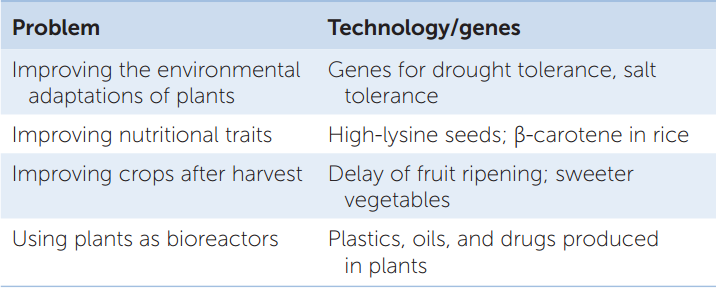
Some bacteria generate proteins that can kill insects. For example, Bacillus thuringiensis produces a protein (Bt) that is toxic to the insect larvae that prey on this bacterium:
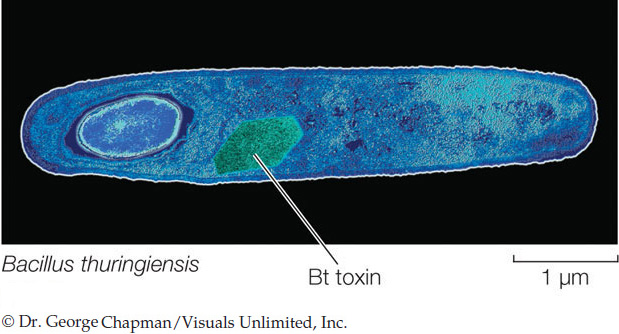
The Bt protein is 80,000 times more toxic than a typical commercial insecticide. When a hapless insect larva eats the bacteria, Bt is activated and binds specifically to the larva’s gut, producing pores and killing the insect. Dried preparations of toxin-containing B. thuringiensis have been sold for decades as safe insecticides that break down rapidly in the environment. But the biodegradation of these preparations is also their limitation, because the dried bacteria must be applied repeatedly throughout the growing season.
A more permanent approach is to have the crop plants themselves produce the toxin. The Bt toxin gene has been isolated, cloned, and extensively modified by the addition of a plant promoter and other regulatory sequences. Transgenic (also called genetically modified or GM) corn, cotton, soybeans, tomatoes, and other crops are now being grown successfully with this added gene. Pesticide usage by farmers growing these transgenic crops is greatly reduced.
Grains With Improved Nutritional Characteristics
To remain healthy, humans must consume adequate amounts of β-carotene, which the body converts into vitamin A. About 400 million people worldwide suffer from vitamin A deficiency, which makes them susceptible to infections and blindness. One reason is that rice grains, which do not contain β-carotene, make up a large part of their diets. Other parts of the rice plant—and indeed many plants and other organisms—contain enzymes for the biochemical pathway that leads to β-carotene production.
Plant biologists Ingo Potrykus and Peter Beyer isolated one of the genes for the β-carotene pathway from the bacterium Erwinia uredovora, and another from daffodil plants. They added a promoter and other signals for expression in the developing rice grain, and then transformed rice plants with the two genes. The resulting rice plants produce grains that look yellow because of their high β-carotene content. A newer variety with a corn gene replacing the one from daffodils makes even more β-carotene and is golden in color (FIGURE 13.15). A daily intake of about 150 grams of this cooked rice can supply all the β-carotene a person needs. This new transgenic strain has been crossed with strains adapted for various local environments, in the hope of improving the diets of millions of people.
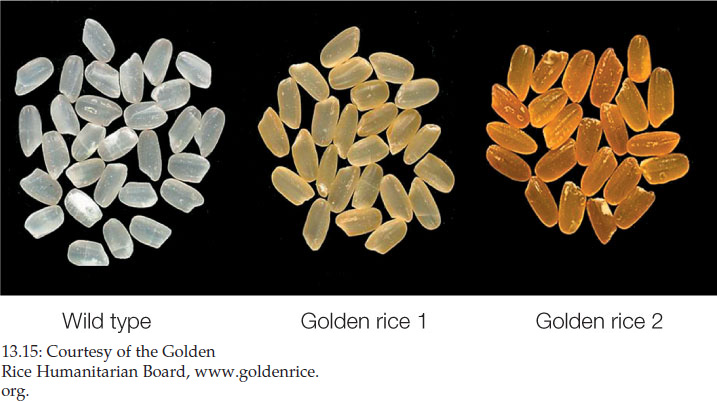
Crops that Adapt to the Environment
Agriculture depends on ecological management—tailoring the environment to the needs of crop plants and animals. A farm field is an unnatural, human-designed system that must be carefully managed to maintain optimal conditions for crop growth. For example, repeated irrigation meets the water needs of crops but results in increases in soil salinity. The Fertile Crescent, the region between the Tigris and Euphrates rivers in the Middle East where agriculture was practiced 10,000 years ago, is no longer fertile. It is now a desert, largely because the soil has a high salt concentration. Few plants can grow on salty soils, partly because of osmotic effects that result in wilting, and partly because excess salt ions (Na+) are toxic to plant cells.
Some soils are naturally salty, and some plants can tolerate salty soils because they have a protein that transports Na+ out of the cytoplasm and into the vacuole, where the ions can accumulate without harming plant growth (see Concept 4.3 for a description of the plant vacuole). Scientists have developed a highly active version of the gene encoding this protein and have used it to transform crop plants—including rapeseed, wheat, and tomatoes—that are normally less tolerant to salt. When the gene was added to tomato plants, they grew in water that was four times more salty than the typical lethal level (FIGURE 13.16). This finding raises the prospect of growing useful crops on previously unproductive soils.
270

LINK
Other stress adaptations of plants—some of which could be beneficial if introduced into crop plants—are discussed in Concept 28.3
The example described here illustrates what could become a fundamental shift in the relationship between crop plants and the environment. Instead of manipulating the environment to suit the plant, biotechnology may allow us to adapt the plant to the environment. As a result, some of the negative effects of agriculture, such as water pollution, could be lessened.
There is public concern about biotechnology
Concerns have been raised about the safety and wisdom of genetically modifying crops and other organisms. These concerns are centered on three claims:
- Genetic manipulation is an unnatural interference with nature.
- Genetically altered foods are unsafe to eat.
- Genetically altered crop plants are dangerous to the environment.
Advocates of biotechnology tend to agree with the first claim. However, they point out that all crops are unnatural in the sense that they come from artificially bred plants growing in a manipulated environment (a farmer’s field). Recombinant DNA technology just adds another level of sophistication to these technologies.
To counter the concern about whether genetically engineered crops are safe for human consumption, biotechnology advocates point out that only single genes are added and that these genes are specific for plant function. For example, the B. thuringiensis toxin produced by transgenic plants has no effect on people. However, as plant biotechnology moves from adding genes that improve plant growth to adding genes that affect human nutrition, such concerns will become more pressing.
Various negative environmental impacts have been envisaged. There is concern about the possible “escape” of transgenes from crops to other species. If the gene for herbicide resistance, for example, were inadvertently transferred from a crop plant to a closely related weed, that weed could thrive in herbicide-treated areas. Another negative scenario is the possibility that increased use of an herbicide will select for weeds with naturally occurring mutations that make them resistant to that herbicide. This is indeed occurring. Widespread use of glyphosate on fields of glyphosate-resistant crops has resulted in the selection of rare mutations in weeds that make them resistant to glyphosate. To date more than ten resistant weed species have appeared in the U.S.
As we mentioned in the opening story, there are biotechnologically produced microorganisms that are able to break down components of crude oil. These have not been released into the environment because of the unknown effects that such organisms might have on natural ecosystems. However, these organisms potentially provide a way to rapidly clean up catastrophic oil spills.
Because of the potential benefits of biotechnology, most scientists believe that it is wise to proceed, albeit with caution.
271
CHECKpointCONCEPT13.4
- In addition to the coding sequence for a gene of interest, what other DNA sequences are required for the gene to be expressed in a different host?
- What is pharming, how is it done, and what are its advantages over more conventional biotechnology approaches?
- What are the advantages of using biotechnology for plant breeding compared with traditional methods?
- What are some concerns people might have about agricultural biotechnology?
How is biotechnology used to alleviate environmental problems?
ANSWER Among the thousands of species of bacteria, there are many unique enzymes and biochemical pathways. New pathways are continually being discovered as new bacterial species are found (for example, by metagenomics; see Figure 12.6). Bacteria are natural recyclers, thriving on many types of nutrients—including what humans refer to as wastes.
Bioremediation is the use by humans of other organisms to remove contaminants from the environment. Two well-known examples of bioremediation are composting and wastewater treatment. Composting involves the use of bacteria and other microbes to break down large molecules, including carbon-rich polymers and proteins, in waste products such as wood chips, paper, straw, and kitchen scraps. For example, some species of bacteria make cellulase, an enzyme that hydrolyzes cellulose, a major component of plant cell walls and paper. Bacteria are used in wastewater treatment plants to break down human wastes, paper products, and household chemicals.
Bioremediation is also an attractive option for cleaning up oil spills. In 2010 the Deepwater Horizon oil rig in the Gulf of Mexico exploded, and crude oil began gushing out of the well below it. The oil flowed unabated for three months until the wellhead was finally capped; a total of 210 million gallons were released. The oil slick was visible from space—it damaged marine habitats and killed wildlife, washed up on beaches, and shut down fishing and tourism in the area. Efforts to remove the giant slick included collecting the oil, burning it, and dispersing it chemically. In addition, scientists identified bacteria living in the Gulf waters that were able to digest and break down components of the crude oil. Despite the cleanup efforts and the actions of these bacteria, much of the oil remains in the Gulf today.
Oil spills can be remediated by encouraging the growth of natural microorganisms that digest components of crude oil. After the oil tanker Exxon Valdez ran aground near the Alaskan shore in 1989, nitrogen fertilizers were applied to nearby beaches to encourage the growth of oil-eating bacteria. Similar approaches have been tried in Kuwait, where the destruction of oil wells during the 1990–1991 Gulf War led to a massive release of oil (FIGURE 13.17). The success of such methods has been limited, however, because the naturally occurring bacteria digest only certain components of the crude oil, and because of technical difficulties in bringing the organisms into contact with the oil.

In the opening story we described how conventional genetic crosses were used to produce (and patent) bacteria that have the capacity to break down oil. Since that time, scientists have isolated the genes that encode the oil-degrading enzymes from such bacteria and cloned them into vectors (Concepts 13.2 and 13.3). This DNA has been used to transform several species of bacteria that live in environments where oil spills have occurred. However, as we mentioned in Concept 13.4, these genetically modified bacteria have not been released into the environment because of environmental concerns.
272